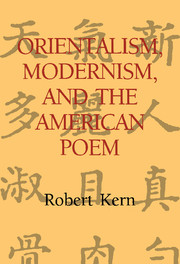Book contents
- Frontmatter
- Contents
- Preface
- 1 Introduction: The European Hallucination
- 2 Emerson and the Language of Nature
- 3 Character Assassination: Representing Chinese in Nineteenth-Century Linguistics
- 4 Otto Jespersen and Chinese as the Future of Language
- 5 Language in Its Primary Use: Fenollosa and the Chinese Character
- Interchapter: Pound, Emerson, and the Poetics of Creative Reading
- 6 Modernizing Orientalism/Orientalizing Modernism: Ezra Pound, Chinese Translation, and English-as-Chinese
- 7 Seeing the World without Language: Gary Snyder and Chinese as American Speech
- Notes
- Index
- CAMBRIDGE STUDIES IN AMERICAN LITERATURE AND CULTURE
1 - Introduction: The European Hallucination
Published online by Cambridge University Press: 23 December 2009
- Frontmatter
- Contents
- Preface
- 1 Introduction: The European Hallucination
- 2 Emerson and the Language of Nature
- 3 Character Assassination: Representing Chinese in Nineteenth-Century Linguistics
- 4 Otto Jespersen and Chinese as the Future of Language
- 5 Language in Its Primary Use: Fenollosa and the Chinese Character
- Interchapter: Pound, Emerson, and the Poetics of Creative Reading
- 6 Modernizing Orientalism/Orientalizing Modernism: Ezra Pound, Chinese Translation, and English-as-Chinese
- 7 Seeing the World without Language: Gary Snyder and Chinese as American Speech
- Notes
- Index
- CAMBRIDGE STUDIES IN AMERICAN LITERATURE AND CULTURE
Summary
Among several possible starting-points for this study, perhaps the most prescient is provided by the publication in Paris in 1811 of a short book entitled Essai sur la langue et la litterature chinoises. Its author, Jean Pierre Abel-Rémusat, twenty-three years old and self-taught in Chinese, not only inaugurated modern sinology but in doing so employed a phrase that, with an already long history in Western perceptions of Chinese, was to become one of the principal signifiers of poetic modernism: “things themselves.”
Disavowing some of the earlier European ideas about Chinese – that it was, for instance, the most rational and systematic of languages, and that it was, therefore, the most likely model for a universal language – Abel- Rémusat nevertheless records his admiration for what he regards as the unique qualities of Chinese. Above all he admires its “energy” – a key term in Enlightenment and romantic theories of language – and it is this energy, especially as it is encountered in the most basic of the Chinese written characters, representing the fundamental ideas of humanity, that can be conveyed, he says, by no other language. What he has in mind is primarily a visual or pictorial quality, and those characters which exhibit it, he asserts, in terms that anticipate the whole postromantic quest for pure experience and unmediated vision, “present to the eye not the sterile and conventional signs of pronunciation but things themselves.” This energy, moreover, is an essentializing and synthesizing force, making for such concision that “several phrases are necessary to exhaust the meaning of a single word.”
- Type
- Chapter
- Information
- Orientalism, Modernism, and the American Poem , pp. 1 - 35Publisher: Cambridge University PressPrint publication year: 1996



